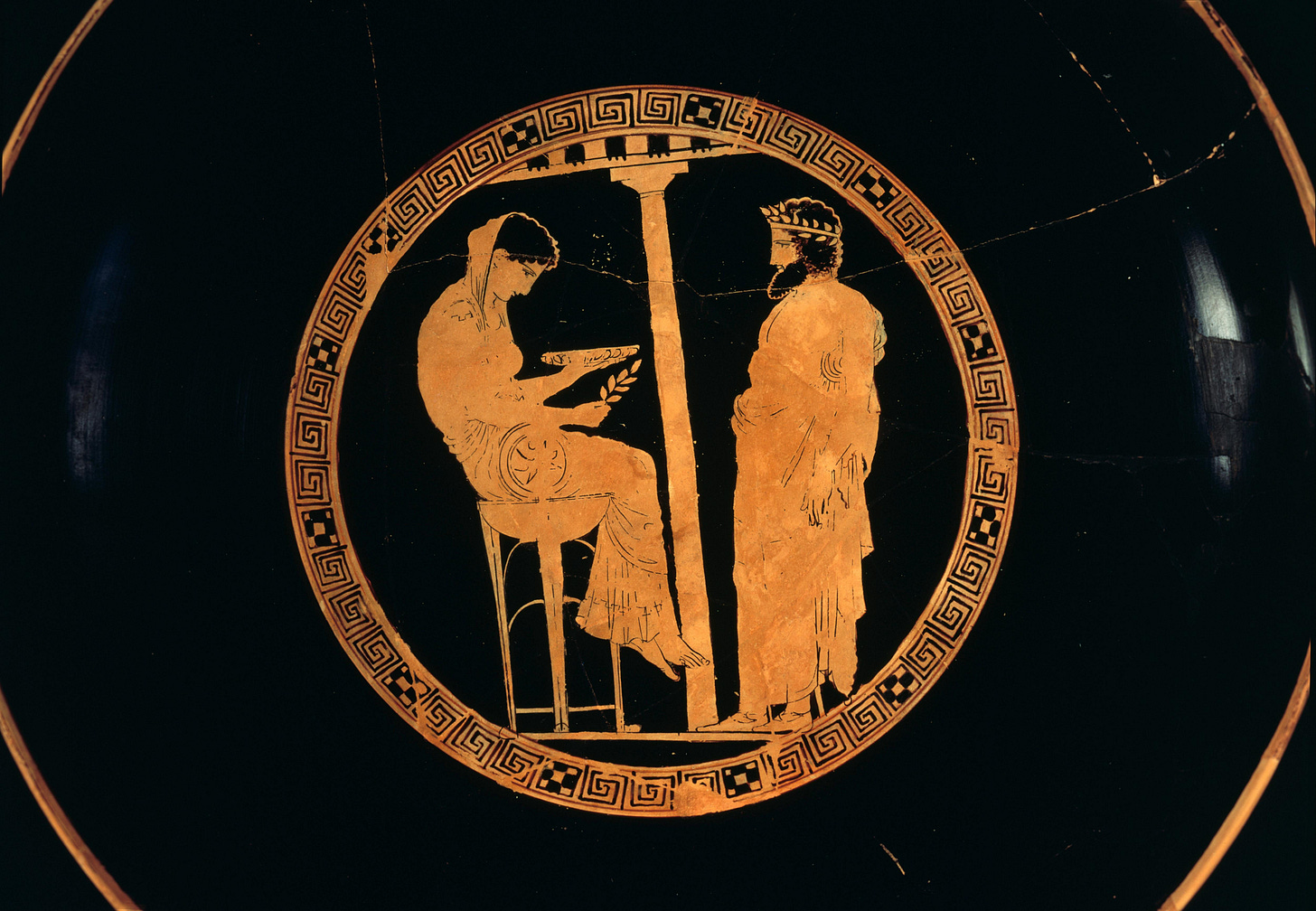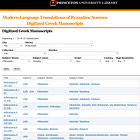The Literary Excavation of Delphi
When marbles belie and manuscripts lie
“We had to stop [our exploration] and be satisfied with what we could learn from books of the former wealth and grandeur of [Delphi]: for nothing remains now but wretched poverty and all its glory has passed like a dream.” — Voyage d’Italie, de Dalmatie, de Grèce et du Levant (1678)
…so wrote Jacob Spon, a French Hellenist, explorer of Greek monuments, and the first person to use the word “archaeologia” — applied during his exploration of the ruins of Delphi.
In my recent guest post for The Classical Futurist I made a provocative assertion that the Greek sanctuary of Delphi — home of the Pythian oracle who provided prophecies for visitors across the ancient Mediterranean — fundamentally existed only in literature for over a thousand years. This period spanned from around 600AD, whence its glistening marbles steadily subsumed under the earth, until the explorations of western Europeans like Jacob Spon and finally its excavation in the late 1800s.

During the centuries when there was no physical place of Delphi that could be visited or found on a map; the town survived in the imaginations and literature of people around the world for centuries. Indeed, Spon asserts that even as it lay completely hidden under the ground in the 1600s, Delphi was still “the most famous place in the world”. The oracular priestess (the Pythia) in her Temple of Apollo was no longer actively shaping the political affairs of the Mediterranean by providing prophecies to consultants like the Spartan lawgiver Lycurgus, desperate Athenians seeking to repel the Persians time and again, or settlement founders in North Africa and Asia Minor as she did from around 700BC to 500AD. Yet Delphi survived as an inescapable reference point for Mediterranean and European societies through the eons of the Middle Ages, Renaissance, and Enlightenment.
Even as Delphi lay dormant under debris, the Temple of Apollo and its Pythia were read in literature ranging from Homer’s Epics, the Athenian tragedians like Euripides, in letters from Roman Emperors, in the philosophies of a once-priest of the temple – Plutarch, and in the exhortations of early Christian theologians like Clement of Alexandria and John Chrysostom. Not mere stories, people read these texts long after the decline of ancient Greece because the literature of ancient Greece writ large was a touchstone for the continuation and development of countless societies’ politics, technology, religion, philosophy, and logic.
In fact, the literature wasn’t merely read, but taught, disputed, and copied – again and again. People like Jacob Spon weren’t reading ancient papyrus scrolls from the actual hands of the ancient authors, but from later manuscripts produced by scribbling scribes in hallowed monasteries and schools in the Middle Ages. The oldest sources available today for ancient Greek literature are primarily manuscripts copied by Byzantine scribes from the 9th to 15th centuries AD based on copies of copies of edits and editions through the centuries. In other words, for over a thousand years the most tangible material form in which Delphi survived was on the tables of scriptoriums, not a marble complex in Greece.

This indelibly famous concept, Delphi-as-literature, the centre of the ancient world, commanded the mind’s attention as its shadows were projected in ink across pages for over a thousand years while the site itself was lost. However, despite the excitement of Delphi-as-literature, once Delphi-as-place was excavated in the 1890s, an undeniable sense of disappointment lingered through the French team tasked with the “big dig” (Grande Fouille). As Michael Scott explains in Delphi: A History of the Center of the Ancient World, the excavation of Delphi proceeded with the ancient literary sources about Delphi literally in the hands of the archaeologists. But the tantalizing words on the page didn’t often align with what was on the ground. By the end of the ten-year dig there was a feeling that the ancient sources had lied to them. Some extraordinarily fine pieces of sculpture, scattered inscriptions, and architectural shards had been uncovered, but compared to all the wonderful objects and allusions in the ancient literature, it simply didn’t measure up.
Archaeologists looked to confirm their literary sources through the excavation. Plutarch, Chrysostom, and others wrote of the Pythia inhaling some kind of ‘pneuma’ – vapors or fumes – from a chasm which induced her prophetic state. The search for the chasm came up short. Archaeologists also hoped to clarify details in the literature, such as how and where the Pythia and her consultants stood. Was it in a special chamber of the temple, in an underground floor, or perhaps sunk into the rear cella of the temple? The simple layout of the temple ruins unfortunately don’t provide enough indications to answer this question. Then there was the search for the implements of the oracle, such as the tripod upon which she sat or even Apollo’s lyre and armour. In the end, one critic at the Delphi display at the 1901 Universal Exhibition complained that, regarding Delphi, “there is nothing to do but rely on one’s imagination.”
I recently had the great fortune to visit Delphi, and while the critic’s response seems to rather overstate that there is nothing to do – Delphi is still an evocative place – the ruins do require some creative imagination: especially for the Temple of Apollo. The vast majority of the 500,000 annual visitors to Delphi arrive on a guided tour, while others read the plaques on site or don guidebooks and self-guided audio tours. These guides explain how the Pythia is named after the serpent Python, who was slain by Apollo. They outline the procession of benefactors, pilgrims, and soothsayers who reached the temple’s doorstep and underwent ritual and payment in order to gain an audience with the oracle. They discuss the allegedly manic trances the oracle underwent – “right here! inside the temple before you!” – in order to deliver incoherent prophecies to kings from Greece to Egypt to Anatolia that changed the course of world history.
Then you look over at the remains of the temple before you. The temple is cordoned off with a low rope and visitors aren’t permitted to step inside the temple – however much one can step ‘inside’ what is essentially a collection of arranged foundation stones. Just as archaeologists anguished over just where and how the ancient tales may have occurred, you, the visitor, are faced with the same dilemma. Despite standing right there, close enough to nearly touch the marble columns countless famous figures strode past, you still must read, configure, and imagine the site from afar. Despite the spectre of history bearing down on you, and the sun beating down right over you, the temple feels distant.
This isn’t to disparage Delphi. While some other ruins inside Greece, and especially outside Greece are in better states of preservation and their architecture can be explored with the senses (the subject of my next essay), most Greek sites have transcended any corporeal presence and survive independently of a physical coil. Even after re-emerging from an underground slumber of a thousand years, it is Delphi-as-literature through the old literary sources, not Delphi-as-place in the vacant corpse in front of you, that acts as the ventriloquist animating Delphi.

Sources for this essay and related research on the transmission of ancient Greek literature from antiquity to today can be found at my living annotated bibliography below.




Wonderful. I loved this.
Thank you for this. I always enjoy your posts!